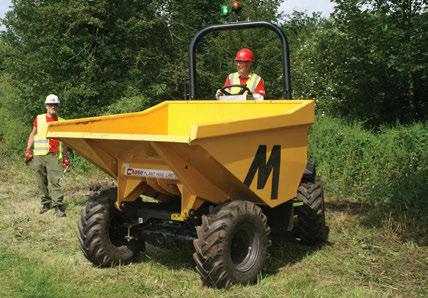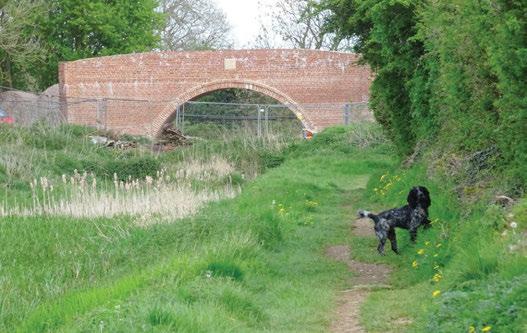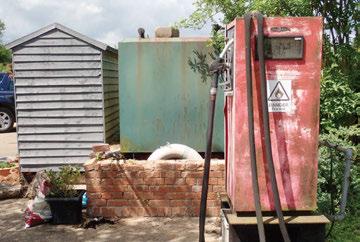
14 minute read
Restoration Hub
restoration HUB: Actions and Achievements
Two years ago we launched a fi ve-year plan, part of which presented ‘restoring’ as one of four key strands of our work. As we come to the close of the second year of our objectives and to the fi nal quarter of our twoyear Historic England National Capaci Building grant, we review where we are and share plans with members about what’s coming up next for restoration.
Hub foundations
IWA’s Restoration Hub was established before the announcement of the fi ve-year plan. The Hub seeks to champion, enable and support the restoration movement, and its direction is focused by the Hub’s strategic advisory team known as the High Level Panel. The team is made up of infl uential and experienced leaders of the restoration movement who meet to consider the key issues facing the sector. Their latest thinking is summarised in the graphic [right] and can be boiled down to a small number of core areas: funding, leadership, stakeholders and legislation, and fi nally resources, which includes volunteers, their skills and training. These areas have become the basis of the Restoration Hub’s plans and the foundation for our fi ve-year objectives.
Raising awareness
The fi ve-year plan looked towards the creation of an exciting, vibrant and robust restoration sector that can deliver successes as well as reopenings. To support this aim, IWA will continue to build its reputation as the go-to provider of knowledge, advice and resources for waterway restoration projects. In fact, the last few years have seen some signifi cant reopenings, such as Lock 15 on the Grantham Canal and Phase 1a of the Cotswold Canals, and these certainly go some way to delivering excitement in the sector. However, it’s important to remember that all of these are signifi cant, long-term, o en multi-million pound construction projects, which in many cases operate without broader public recognition or support. IWA is ideally placed to raise awareness of the sector overall and to access specifi c audiences, such as national government, local authorities, a greater diversi of volunteers and national media, to bring new a ention and support to the work of the movement. In the last year we have secured coverage for restoration on BBC’s Country File as well as in national newspapers such as the Observer and Guardian.
issues facing restoration
resources
Succession Planning
Issues: • Recruiting volunteers at all levels • Finding the right people for the right projects
skills
Issue: • Developing volunteer competency and expanding the sector’s skill base
knowledge
Issue: • How to share best practice across a national movement
one voice
champion restoration
Issue: • How to gain high level political visibili as well as recognition and support om the public
stakeholders & legislation
environment
Issues: • Demonstrating environmental benefits of restoration • Environmental rules and regulations challenge to navigate, creating barriers to progress
Heritage & Planning
Issues: • Limited understanding of waterways heritage • Route securi of derelict canals threatened by developers and local authorities ignoring local plan
funding
Issues: • How do restoration groups secure adequate funding to deliver their projects • Post-Brexit heritage funding may be a ected
strategic Planning & priorities
Issues: • A finite set of resources needs to be used for maximum benefit • How does a fragmented sector respond to national issues
working in partnership
Issue: • Ine ective relationships with important stakeholders
Training and skills-sharing
Site health and safe has been an area where IWA has invested considerable resources to provide a lead to restoration groups. One of the largest investments has been in the recruitment of the Hub’s technical o cer, who provides technical support to restoration groups on project planning, risk assessment and method statements. Since the fi ve-year plan was published the restoration team has worked on three core health and safe tuition videos: Creating a Culture of Safe , Construction, Design & Management Regulations 2015, and Project Planning. They have been shared with restoration volunteers and video training has been supplemented by workshops on technical topics such as working at height and temporary works. This pe of training aims to li the skill and knowledge base of volunteers across the sector.
The technical o cer takes his skills and advice direct to restoration sites to provide technical support and knowledge-sharing in situ. Recently they have also been invited to undertake independent health and safe audits for several restoration groups to identi gaps in paperwork and propose an improvement plan. Meanwhile, restoration volunteers have been given the opportuni to a end site supervisors safe and fi rst aid training schemes, run by external trainers and organised by IWA’s restoration team.


The Restoration Group has produced health and safety videos to supplement their onthe-ground training courses.
Learning bricklaying on a WRG training weekend. Training volunteers on plant and machinery allows restoration groups to become selfsuffi cient.
Canal Camps for all
Waterway Recovery Group provides the hands-on practical support for restoration groups nationwide through its week-long, working holidays known as Canal Camps, as well as through weekend digs provided by WRG’s regional groups (see page 32 for details of this summer’s camps). Since our fi ve-year plan was published, 41 Canal Camps have taken place, delivering over 30,000 volunteer hours to restoration groups across 15 diff erent sites. The objective is to deliver “inspiring, high-quali restoration work, using a skilled and motivated volunteer workforce”. Inglesham Lock, the gateway to the Cotswolds linking the River Thames to the Cotswold Canals restoration, has enjoyed concentrated WRG camps over the last two years and is now close to completion. The WRG team is looking forward to 2020 with some anticipation as there is the potential for teams to work on two similar-sized projects. This pe of work, where our volunteers can make a signifi cant diff erence to a restoration and where all the skills and experience of our volunteers can be employed in a much more involved and coordinated way, should bring new levels of motivation and upskilling.
The team behind Canal Camps has looked to extend its reach to try and a ract new, diverse audiences to restoration volunteering and to use the working holidays as a gateway to the wider waterways volunteering sector.
Family camps, shorter three-day events a racting three generations of families in some locations, are aimed at children aged six to 14 years old and their guardians. Run on the U oxeter, Grantham and Wendover canals, these camps have allowed young volunteers and their families to be introduced to the world of canal restoration through a programme of activities such as Himalyan balsam clearance, archaeology and habitat creation. The camps have received fantastic feedback and we plan to continue running them for the foreseeable future. There is a new, teen programme in the planning stages, which will be focused on providing basic skills to 16- and 17-year-olds, preparing them for Canal Camp a endance when they reach 18. The hope is to include this programme in a broader youth engagement scheme and grant funding will be sought to support this project in coming to שׁ uition.
Expert advice
Planning expertise, through the Planning Advisory Panel, and engineering advice, through IWA’s Honorary Consultant Engineers, have been supplemented by fundraising, public relations, marketing and environmental skills off ered by a broad panel of professionals. The Restoration Hub team has answered an enormous range of questions, fi elding around ten detailed requests per month on topics as diverse as waste management for dredging operations and winding hole specifi cations.
The Heritage Advisory Group has most recently established a שׁ amework for its remit and plans to issue a report which spans both restoration and navigable waterways heritage in 2020. The advice takes the form of reports, detailed professional advice, verbal recommendations and training.
A Governance Advisory workshop was off ered in October 2019 as well as fundraising digital clinics in September. Detailed plans are being hatched for IWA’s annual restoration conference organised in conjunction with Canal & River Trust, off ering the opportuni for more than 120 restoration volunteers to learn directly שׁ om the experiences of other sectors with similar experiences as well as specifi c learning שׁ om waterway restoration specialists. The programme of training is ongoing and is organised at least six months in advance. There are plans in place to expand the breadth and depth of expert advice off ered.
One of the fi ve-year objectives proposed the development of a ‘wiki’ for restoration, accessible by waterway restoration volunteers. This proposal has been superseded by plans for a new online resource to be developed as part of IWA’s new website plans (see page 10).
Supporting the sector
The fi nal objective has collaboration and partnership working at its heart. The launch of the Waterways in Progress report has been a great example of how IWA has supported the sector to ampli the benefi ts of restoration activi . Presentations at the World Canals Conference and to MPs and Lords, and a stand at the Socie of Local Authori Chief Executives annual conference, have meant the message of ‘restoration today’ has been shared widely. Restoration schemes have circulated the report and video generously to local legislators and quotes שׁ om the report have been used as part of grant funding applications. The High Level Panel has asked for reports wri en by the Inland Waterways (Ameni ) Advisory Council to be updated/reviewed and recirculated as much of the content of these reports has value for other organisations outside of the restoration communi . IWA is planning an event for the construction/developer communi in 2021 as part of its 75th anniversary celebrations and the benefi ts of restoration will be a central message at this conference.
Opportuni knocks at every stage of a restoration and IWA is keen to ensure that each and every one is seized along the way.
CASE STUDY
Buckingham Canal Socie
How the Restoration Hub has supported this waterways project: • BCS has received fundraising advice via our
Virtual Funding Surgery and receives the
Grants Online Newsle er arranged by IWA • Weekend work parties on the canal have been carried out by WRG’s regional groups • Volunteers שׁ om BCS have a ended IWA’s
Restoration Hub workshops on high-risk activities, including temporary works and working at height • The Hub has funded one place for a BCS volunteer to a end a CITB-approved Site
Supervisors Safe Training Scheme course • The Hub partially funded one volunteer’s
PRINCE2 and MSP Foundation Level qualifi cations via a training grant • Our Driver Authorisation Instructors have trained BCS volunteers on plant and vehicles. Some have been trained up to instructor status so the socie can be self-suffi cient in regards to their future requirements • Hub experts have conducted an environmental site habitat survey for BCS’s proposed route, providing a supporting statement, and audited the socie ’s works project plan, liſt plans and risk assessments.
More information
To read the Waterways in Progress report visit waterways.org.uk/ waterwaysinprogress.

restoration HUB:
Looking back on summer 2019 with WRG
The nights are drawing in and the temperature is dropping – a sure sign that summer is over. Although the weather was a bit of a mixed bag this year, our dedicated Waterway Recovery Group Canal Camp volunteers turned out in force to help restore navigations all over the country.
This year, volunteers spent time on nine different sites across 20 week-long working holidays. A total of 303 volunteers joined the WRG Canal Camps spending 1,818 volunteer days in all working on the waterways. That’s a staggering 14,544 volunteer hours on practical restoration.
WRG has had a successful summer across the board, here are some of the highlights:
Wey & Arun Canal

This was WRG’s most technical project this summer, and volunteers worked on the creation of a new lift-bridge that will eventually allow boats to reach the new Birtley section of the canal. During these camps volunteers supported the Wey & Arun Canal Trust in creating the foundations for the lift-bridge. Over 5½ tons of reinforced steel, 7,000 ties and 22m³ of concrete were used during the three weeks.
Lichfield Canal
Cotswold Canals: Weymoor Bridge
A small team of specialist WRG volunteers supported the Cotswold Canals Trust on the final push to complete Weymoor Bridge at Latton. Experienced machine operators landscaped the site and profiled the new roadway running over the bridge, allowing for the temporary diversion route to finally be removed. In preparation for resurfacing of the road, volunteers also put in place new kerb stones.
Groups of volunteers spent three weeks at Fosseway Heath Nature Reserve where they excavated the Lichfield Canal channel and repointed and restored the old towpath wall using the original bricks. In total, WRGies dug out a 120m channel and reinstated the towpath.
Grantham Canal

With the restoration of Lock 15 completed in 2018, attention was shifted to Lock 14 on the Woolsthorpe Flight for this year’s Canal Camps. Supporting the Grantham Canal Trust’s rebuild, WRG volunteers laid bricks, completed concrete pours, landscaped and repointed the wingwalls among other tasks. WRG provided external bricklaying training during the Canal Camps to help develop volunteers’ skills. With excellent progress made this summer, it is expected that the whole lock will be restored by early 2020.
Derby Canal
Camp dates: 20th-27th July on one camp

Volunteers supported the Derby & Sandiacre Canal Trust’s work on the derelict Borrowash Bottom Lock and were involved in uncovering and rebuilding the original stone walls above and below the lock chamber, installing large coping stones and landscaping the area surrounding the structure. WRGies even spent one evening abseiling down an old aqueduct!
The completed Weymoor Bridge.
WRG’s efforts on Weymoor Bridge will allow restoration of the Thames & Severn Canal to continue.
Digger operator Adrian Sturgess excavates the Lichfield Canal channel at Fosseway Heath.

Cotswold Canals: Dudbridge Lower Lock
After a last-minute relocation of a Canal Camp, volunteers arrived at Dudbridge Lower Lock to uncover and begin repairs to this structure, which had developed a void behind the brickwork. Volunteers erected the scaffolding and began deconstructing the lock chamber. The team also had awaydays to work on Weymoor Bridge, Ryeford Double Locks and Goughs Orchard.
Swansea Canal
Camp dates: 23rd-31st August on one camp
Moving from Ynysmeudwy Lower Lock, where the 2018 Canal Camp was based, to the Upper Lock, volunteers cleared vegetation, repointed the lock chamber with lime mortar and rebuilt one of the paddle arches. Working alongside Swansea Canal Society and Canal & River Trust, the team helped secure the future of this old lock.
Chelmer & Blackwater Navigation
Camp dates: 23rd-31st August on one camp
This wasn’t a typical Canal Camp as volunteers worked on an active navigation to support the ongoing efforts of the small and committed team that manages this waterway. Over the course of the week, tasks included improving facilities at Paper Mill Lock, renovating a storage shed, building canoe racks, improving landing stages and helping repair the weir.
Monmouthshire Canal
Volunteers returned to the lock-keeper’s cottage at Ty Coch to continue the archaeological excavations on this canalside heritage structure. The team meticulously uncovered and documented artefacts that helped show what life was like for those who lived in the area when this part of the canal was navigable.

Still to come in 2019
Reunion Weekend
This will take place on the Uttoxeter Canal on 2nd and 3rd November. This annual get-together is a working party for up to 80 volunteers who have attended a previous Canal Camp. Known as the Bonfire Bash, the weekend is usually spent clearing vegetation along the line of the canal and then burning it. It is a fun weekend and a great way to catch up with old friends as well as making new ones.
Christmas Canal Camp
If you are looking for something different to do over the festive season, then why not sign up for the Christmas Canal Camp? The camp runs from 26th December to 1st January. The site hasn’t been confirmed yet so keep an eye on the website for details.
If you would like to find out more about the WRG Canal Camps, just visit our website waterways.org.uk/wrg.
Looking for leaders with 2020 vision
The WRG Canal Camp team is already planning for 2020 and is looking for your help. Every year, WRG needs over 80 volunteer leaders, assistants and cooks to ensure that the camps are fun, well planned and, most of all, safe. If you think you, or someone you know, have the skills to become a Camp Leader, we would love to hear from you. Full training is given. Email WRG at enquiries@waterways.org.uk to find out more.










